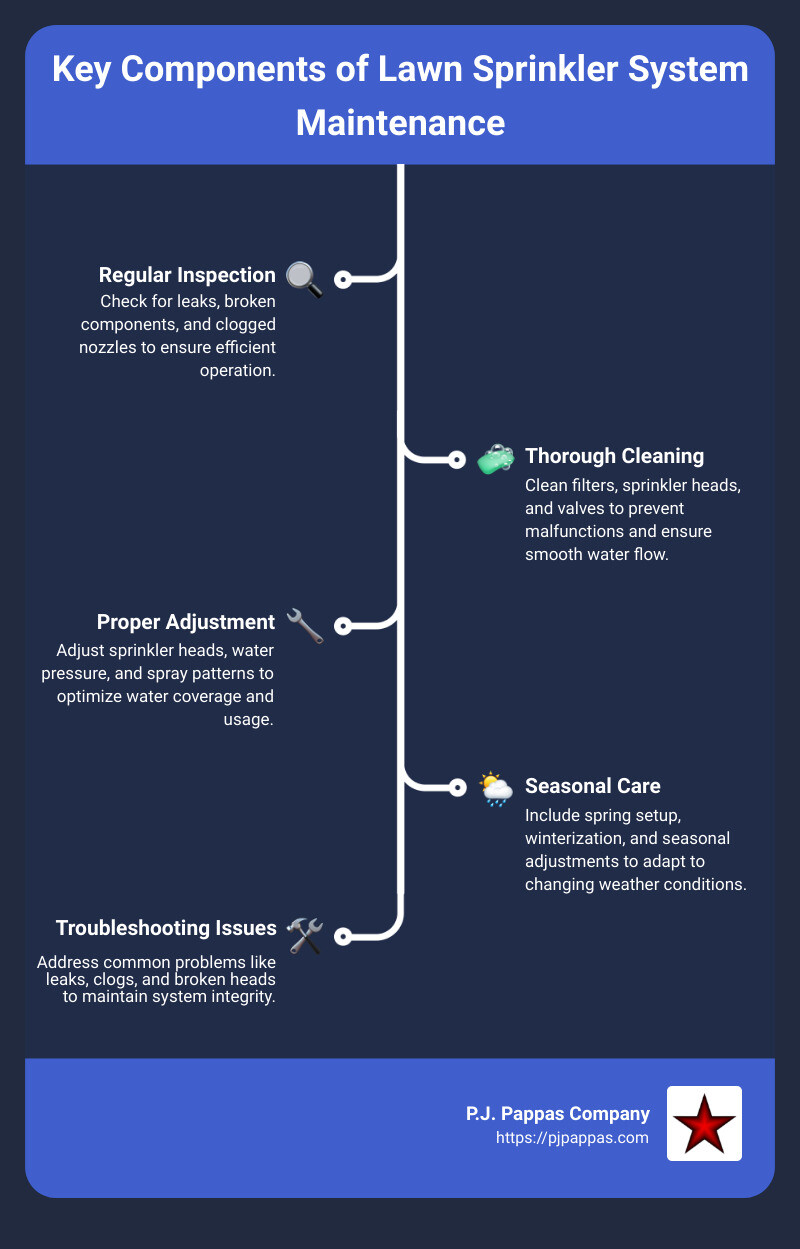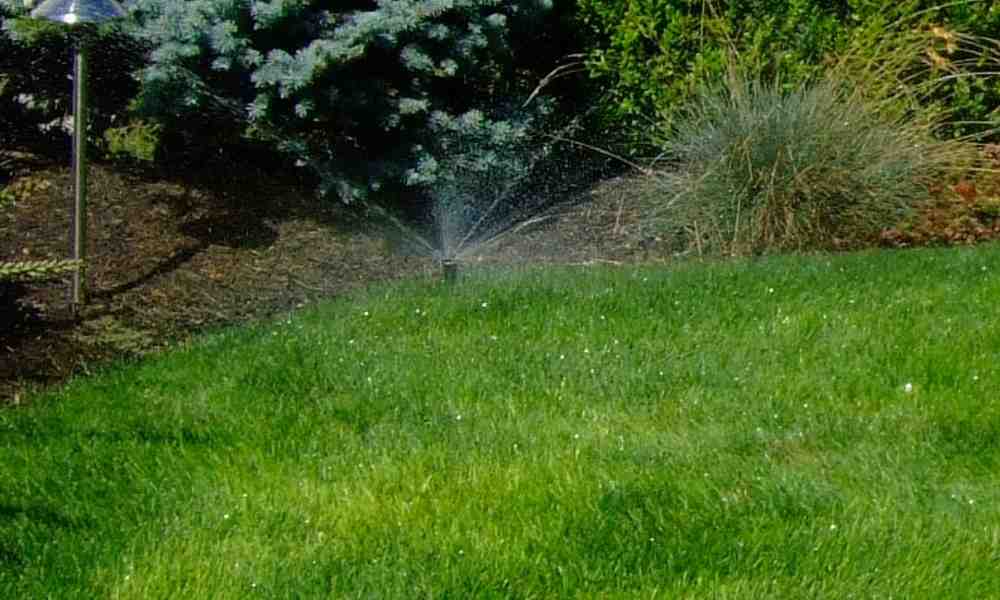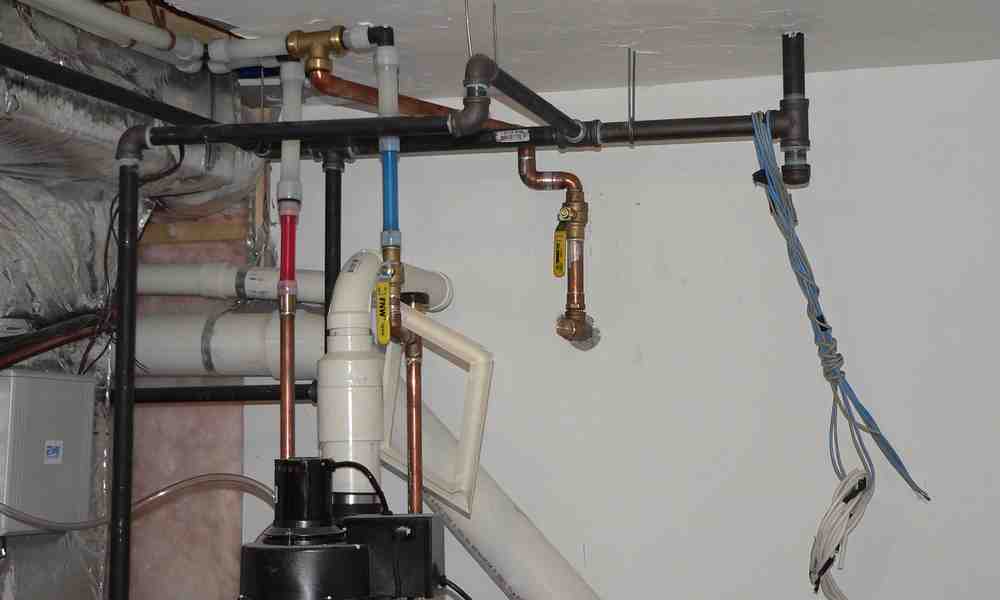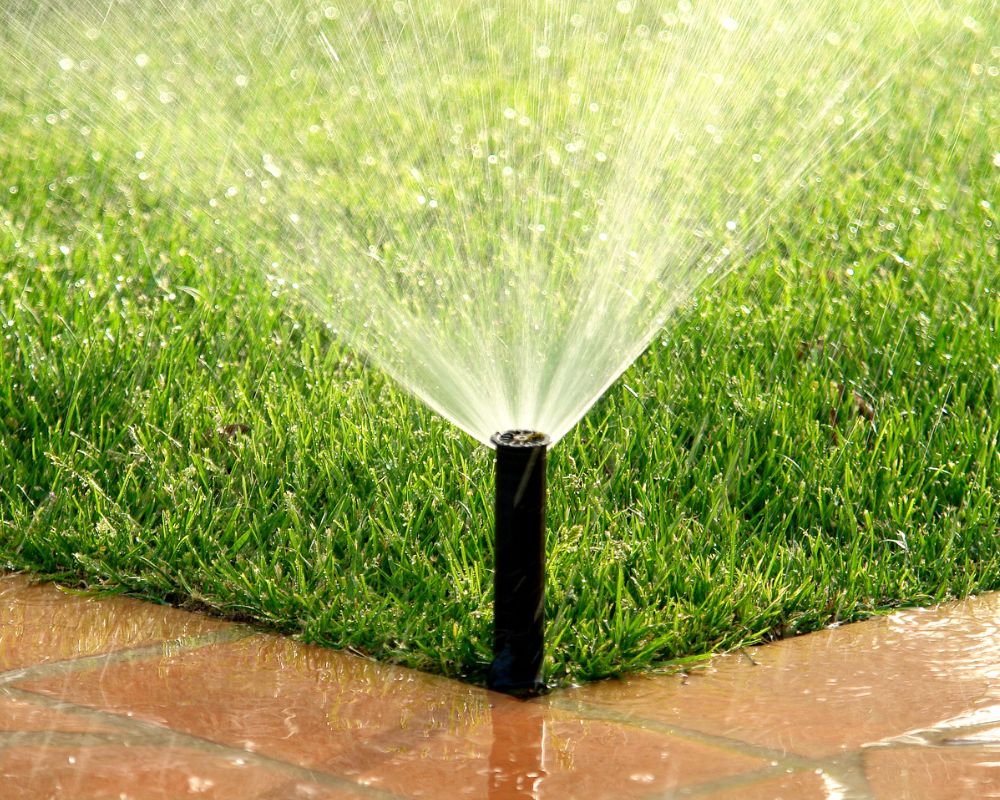Lawn Sprinkler System Maintenance: Top 5 Essential Tips for 2024
Introduction
Lawn sprinkler system maintenance is crucial for ensuring your irrigation system’s longevity and efficiency. Properly maintaining your sprinkler system not only helps preserve your lawn’s lush, green appearance but also significantly cuts down on water use and reduces unnecessary expenses. Whether you’re a homeowner or manage commercial property in Middlesex County, MA, understanding the importance and benefits of regular sprinkler system upkeep can save you from costly repairs and headaches down the line.
Maintaining your lawn sprinkler system involves a few key practices: regular inspections for leaks or damages, thorough cleaning of filters and heads, and correct adjustments to ensure optimal watering coverage. These steps help prevent common issues such as clogged nozzles, leaky valves, and uneven watering, which can lead to water waste and an unhealthy lawn.
Additionally, seasonal care—such as spring setup and winterization—plays a pivotal role in maintaining system effectiveness throughout the year. These adjustments account for changes in weather and landscape needs, ensuring that your sprinkler system operates efficiently no matter the season.
Essential Lawn Sprinkler System Maintenance Steps
Maintaining your lawn sprinkler system is crucial for ensuring its longevity and effectiveness. By following a few key steps such as regular inspection, thorough cleaning, and proper adjustment, you can keep your system running smoothly and your lawn looking its best.
Regular Inspection
Regularly inspecting your sprinkler system helps catch issues before they become major problems. Look for:
- Leaks: Check for wet spots in your lawn, which can indicate a leak. A high water bill can also be a sign of a hidden leak.
- Broken Components: Inspect sprinkler heads and valves for any visible damage or signs of malfunction.
- Clogged Nozzles: Make sure the water spray from your sprinkler heads is even and consistent. Any irregularity might suggest a clog.
Thorough Cleaning
A clean system is an efficient system. Perform these cleaning steps regularly:
- Filters: Clean the filters by removing them and rinsing off any debris. This should be done at least twice a year to prevent clogging and maintain water flow.
- Sprinkler Heads: Remove the heads and soak them in a solution of water and vinegar to dissolve mineral deposits. Rinse thoroughly before reinstalling.
- Valves: Ensure that valves are free of debris by flushing them with water. This helps to prevent malfunctions and leakage.
Proper Adjustment
Adjusting your sprinkler system ensures it waters your lawn efficiently without waste:
- Sprinkler Heads: Adjust the heads to ensure they are not spraying water onto sidewalks or buildings. This helps in conserving water and ensuring it reaches only the areas where it’s needed.
- Water Pressure: Too much pressure can cause misting, which wastes water. Adjust the pressure so that the water droplets are large enough to resist wind.
- Spray Patterns: Modify the spray patterns to cover only the lawn areas. This prevents over-watering and ensures even distribution.
By following these essential maintenance steps, you ensure that your lawn receives the right amount of water without waste. Regular maintenance not only helps in conserving water but also extends the life of your sprinkler system, making it a wise investment for any homeowner. A well-maintained lawn sprinkler system not only saves you money but also keeps your lawn healthy and green.
Seasonal Care for Your Lawn Sprinkler System
Proper seasonal care is crucial for maintaining your lawn sprinkler system’s efficiency and longevity. As the seasons change, so do the needs of your irrigation system. Here’s how to adapt your system maintenance with the changing seasons:
Spring Setup
Spring is a critical time for lawn sprinkler system maintenance. As you prepare your system for the upcoming watering season, follow these steps:
- Flush the system: Slowly open the main valve to fill the pipes and allow the water to flush out any debris that might have accumulated over the winter. This helps prevent clogging and ensures smooth operation.
- Check the controller: Inspect your system’s controller to ensure it’s functioning correctly. Replace any worn or damaged parts and update the firmware if necessary to take advantage of any new features or improvements.
- Update the watering schedule: Adjust the watering schedule based on the current weather conditions and the specific needs of your lawn. Spring often requires less water than the hot summer months.
Winterization
To protect your sprinkler system during the cold winter months, you need to take steps to prevent freezing and damage:
- Drain the pipes: Use compressed air or manual drain valves to remove all water from the irrigation system. This prevents the pipes from freezing and bursting.
- Insulate components: Cover above-ground components with insulation materials to protect them from freezing temperatures. This includes backflow preventers and exposed piping.
- Shut down the system: Turn off the water supply to your sprinkler system and power down the controller. This ensures that the system remains inactive until you’re ready to start it up again in the spring.
Seasonal Adjustments
Throughout the watering season, it’s important to make occasional adjustments to maintain efficiency and effectiveness:
- Adjust the watering schedule: Monitor the weather and adjust your sprinkler’s schedule accordingly. Reduce watering in rainy periods and increase it during dry spells.
- Sensor checks: Regularly check rain sensors and moisture sensors to ensure they are functioning properly. These devices help prevent overwatering by automatically adjusting the watering schedule based on the actual moisture levels of your lawn.
- Efficiency tweaks: Look for opportunities to improve the efficiency of your sprinkler system. This might include adjusting spray patterns, fixing leaky components, or upgrading to more efficient nozzles and sprinkler heads.
By following these seasonal care steps, you can ensure that your lawn sprinkler system operates effectively year-round, conserving water and saving money. Proper maintenance not only extends the life of your system but also helps maintain a healthy, green lawn. A little time spent on maintenance can prevent costly repairs and inefficiencies later.
As we move into the next section, we’ll explore how to troubleshoot common issues that may arise with your sprinkler system, ensuring you’re well-equipped to handle any problems that come your way.
Troubleshooting Common Sprinkler System Issues
Troubleshooting your lawn sprinkler system doesn’t have to be a daunting task. By understanding common issues such as leaks, clogs, and broken heads, you can keep your system running smoothly and efficiently.
Detecting and Fixing Leaks
Leaks in your sprinkler system can lead to high water bills and water waste. Here’s how to spot and fix them:
- Look for Wet Spots: Regularly walk around your lawn to check for unusually soggy areas or pooling water. These can be signs of a leak.
- Monitor Your Water Bill: An unexpected increase in your water bill often indicates a leak somewhere in your system.
- Repair Techniques: Once you locate a leak, it may involve tightening connections or replacing damaged pipes or fittings. For complex leaks, it may be wise to contact a professional like P.J. Pappas Company.
Clearing Clogs
Clogs can prevent your sprinkler system from distributing water evenly. Follow these steps to clear them:
- Clean Filters: Remove and clean the filters in your sprinkler heads at least twice a year. A simple rinse or gentle scrub can remove debris.
- Rinse Heads: Detach the sprinkler heads and rinse them in clean water to clear out any dirt or sand that might be blocking the water flow.
- Flush System: Periodically turn on the system and let it run for a few minutes without the sprinkler heads. This helps flush out any debris trapped in the pipes.
Repairing Broken Sprinkler Heads
Broken sprinkler heads can disrupt the spray pattern and affect the efficiency of your system. Here’s how to fix them:
- Identify Damage: Check for visible signs of damage like cracked casings or broken nozzles.
- Replacement: If a sprinkler head is beyond repair, replace it with a new one that matches the specifications of your system.
- Adjustment: Make sure the new or repaired head is properly aligned with the correct spray pattern to ensure even water distribution.
By regularly checking for these common issues and performing simple maintenance tasks, you can ensure that your lawn sprinkler system operates effectively year-round, conserving water and saving money. Proper maintenance not only extends the life of your system but also helps maintain a healthy, green lawn. A little time spent on maintenance can prevent costly repairs and inefficiencies later.
As we move into the next section, we’ll delve deeper into optimizing water use and system efficiency, providing you with strategies to enhance the performance of your lawn sprinkler system.
Optimizing Water Use and System Efficiency
To maximize the benefits of your lawn sprinkler system, focusing on water conservation and system efficiency is crucial. These strategies not only help in saving water and reducing costs but also extend the longevity of your system.
Water Conservation Techniques
Scheduled Watering: Set your sprinkler to operate during the cooler parts of the day—early morning or late evening. This reduces water loss due to evaporation and ensures that your lawn gets the most out of every drop.
Drip Irrigation: For specific areas like flower beds or vegetable patches, consider installing a drip irrigation system. Drip irrigation delivers water directly to the soil at a slow rate, which is highly efficient and reduces wastage.
Rain Sensors: Installing a rain sensor can significantly cut down on water usage. These sensors automatically halt your sprinkler system when it starts to rain, ensuring that you’re not watering your garden while nature is doing it for free.
Enhancing System Efficiency
Upgrade Parts: Over time, sprinkler system components can wear out and become less efficient. Upgrading to high-efficiency nozzles and rotors can help maintain an even water distribution and reduce the amount of water used.
Smart Controllers: Smart controllers adjust watering schedules based on weather conditions, soil type, and plant water use. They can dramatically improve the efficiency of your sprinkler system by ensuring that your lawn receives the optimal amount of water at the right time.
Coverage Optimization: Regularly check and adjust the positioning of your sprinkler heads to make sure they’re not watering non-grassy areas like sidewalks or driveways. Properly aligned sprinkler heads maximize coverage and efficiency.
By implementing these water conservation techniques and enhancing your system’s efficiency, you can ensure that your lawn remains lush and green without wasting water or increasing your bills. These steps not only contribute to environmental conservation but also optimize the operation of your lawn sprinkler system for long-term reliability and performance.
Frequently Asked Questions about Lawn Sprinkler System Maintenance
As you strive to keep your lawn lush and your watering efficient, you might have some questions about maintaining your lawn sprinkler system. Here are answers to some common inquiries.
How often should I clean my sprinkler system?
Regular cleaning is crucial for keeping your system in top shape. Aim to clean your system at least twice a year: once in the spring before you start regular usage, and once in the fall when you prepare the system for winter. Additionally, check for and clean out any clogged nozzles or filters every month during the watering season to prevent disruptions in water flow and ensure even coverage.
What is the best way to winterize my sprinkler system?
Winterizing your sprinkler system is essential to prevent freezing and subsequent damage. Here’s a simple step-by-step guide:
- Turn off the water supply to your sprinkler system.
- Drain all water from the pipes, valves, and sprinkler heads. You can use manual drain valves or an automatic drain system to do this.
- Blow out remaining water using compressed air if recommended for your system (always check the manufacturer’s guidelines or consult with a professional like P.J. Pappas Company to avoid damaging your system).
- Insulate any exposed piping and backflow preventers to protect them from freezing temperatures.
How can I improve the efficiency of my sprinkler system?
Improving the efficiency of your lawn sprinkler system not only saves water but also reduces your utility bills and helps maintain a healthier lawn. Consider these tips:
- Adjust your sprinkler heads regularly to ensure they only water the lawn and not the paved areas.
- Install a smart controller that adjusts watering based on weather conditions, soil type, and plant requirements.
- Add rain sensors to prevent the system from running when it has recently rained.
- Check for leaks and repair them promptly to prevent water wastage.
By following these best practices and giving your system the seasonal care it needs, you can enjoy a vibrant lawn without the high costs or environmental impact of inefficient water use. Regular maintenance and timely adjustments are key to the longevity and performance of your irrigation system. If you’re unsure about handling any aspect of maintenance yourself, consider enlisting the help of seasoned professionals like P.J. Pappas Company to ensure your system is always running smoothly.
Conclusion
Trust Your System to Professionals
When it comes to maintaining your lawn sprinkler system, the long-term benefits of professional maintenance cannot be overstated. By choosing experts like P.J. Pappas Company, you ensure that your system not only operates efficiently but also conserves water and reduces your monthly bills.
Professional maintenance extends the lifespan of your sprinkler system, preventing common issues such as leaks, clogs, and wear and tear on components. This proactive approach saves you money in the long run by avoiding costly emergency repairs and system replacements.
At P.J. Pappas Company, we pride ourselves on our deep expertise in the field of lawn sprinkler systems. With over 37 years of experience, our dedicated team understands the intricacies of various systems, whether they are older models needing careful upkeep or the latest installations requiring fine-tuning for optimal performance.
We offer custom solutions tailored to each client’s unique needs. Whether you have a small residential garden or a large commercial landscape, we design maintenance schedules that ensure your sprinkler system is always at its best. Our services are not just about fixing problems when they arise; we aim to prevent issues before they occur.
By entrusting your lawn sprinkler system to P.J. Pappas Company, you gain peace of mind knowing that your lawn is in the hands of certified professionals equipped with the right tools, skills, and parts to handle any situation. Our commitment to excellence means we don’t just maintain your system; we optimize it to ensure maximum efficiency and water conservation.
Explore our services and see how we can transform your irrigation needs into a seamless, worry-free aspect of your property management. Let us handle the complexities of your sprinkler system while you enjoy a lush, beautifully maintained landscape.
A well-maintained sprinkler system is key to a healthy, green lawn. Trust P.J. Pappas Company to provide the expertise and custom solutions you need for a thriving outdoor space.




